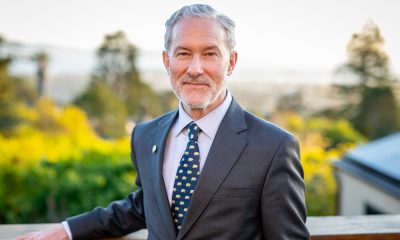Technology
Intel Launches Investment Fund for Minority, Women-Led Firms
BRANDON BAILEY, AP Technology Writer
SANTA CLARA, California (AP) — Intel is launching a $125 million investment fund for technology startups led by women and minorities, a move the chipmaker says is aimed at changing the face of Silicon Valley.
The new fund, which is unusual for its focus on minority-led companies, is part of a broader effort that Intel CEO Brian Krzanich has launched amid widespread criticism of a U.S. tech industry dominated by white male executives and investors.
Krzanich announced plans earlier this year to spend $300 million on diversity efforts and pledged to make Intel’s workforce and executive ranks more closely resemble the U.S. workforce by 2020. Intel has previously said its workforce is about 24 percent female and 12 percent black and Hispanic. The U.S. workforce is about 47 percent women and 26 percent black and Hispanic.
The new investment fund will raise Intel’s commitment to more than $300 million, Intel officials said, although they said there is some overlap and they did not provide financial details. It’s intended to help build a more diverse “ecosystem” of smaller companies and entrepreneurs that plays an important role in the tech industry, Krzanich said Tuesday.
Despite statistics that show few women and minority-led startups receive venture funding, he said Intel wants to show “there are plenty of women- and minority-led startup companies, and we want to work with them.”
The first companies to receive backing from the new program include Venafi, a cybersecurity firm; CareCloud, which makes Internet-based software for the health industry; Brit + Co., which provides classes and an online market for selling do-it-yourself products; and Mark One, which makes a “smart” cup that analyzes the nutritional content of beverages.
To qualify for funding, firms must have a woman or minority founder or CEO, or at least three top executives who are women and minorities, said Lisa Lambert, who is overseeing the fund.
“They will go through the same scrutiny as any Intel Capital deal. This isn’t a social program” added Lambert, who is a vice president with Intel Capital, the giant chip-maker’s investment arm.
While there are nonprofit organizations that support minority-led startups, dedicated investment funds are rare. AOL has a $10 million fund focused on women-led startups. Comcast has a $20 million fund that provides early-stage or “seed” funding to minority startups. Lambert said Intel’s fund will look at startups that are further along in their growth.
“I think we need to see more programs like what Intel is doing, that look at the business opportunities and solutions” offered by minority-led companies, said Edward Avila of Manos Accelerator, a San Jose, California, group that provides mentorship for Hispanic entrepreneurs.
“The challenge for minority startups is not their ability or capacity, it’s their access to capital,” said Butch Wing, a spokesman for the Rev. Jesse Jackson’s Rainbow PUSH organization, which has pressured Silicon Valley companies to improve diversity.
Copyright 2015 The Associated Press. All rights reserved. This material may not be published, broadcast, rewritten or redistributed.
Activism
Self-eSTEM Empowers BIPOC Women, Girls in Science, Math
In January 2025, Self-eSTEM will launch digital and generative AI programming, which provides digital literacy and AI literacy training through an entrepreneurial project-based activity. This programming will be a hybrid (i.e. in-person and online). Additionally, thanks to a grant from Comcast, in spring 2025, the organization will have a co-ed series for middle and high school students.

By Y’Anad Burrell
Special to The Post
In a world where technology plays an increasingly central role in all aspects of life, the importance of Science, Technology, Engineering, and Math (STEM) education cannot be overstated. Recognizing the significance of STEM for the future, focusing on young women and girls is a critical step in achieving gender equality and empowering the next generation.
Self-eSTEM, an Oakland-based non-profit organization, was founded by Adamaka Ajaelo, an Oakland native who had a successful corporate career with several Bay Area technology and non-tech companies. Ajaelo boldly decided to step away from these companies to give 100% of her time and talent to the non-profit organization she started in 2014 in the belief that she can change the game in innovation and future STEM leaders.
Over the course of a decade, Ajaelo has provided futurist tech programming to more than 2,000 BIPOC women and girls. The organization has an Early STEM Immersion Program for ages 7-17, Emerging Leaders Workshops for ages 18-25 and volunteer network opportunities for ages 25 and up.
In January 2025, Self-eSTEM will launch digital and generative AI programming, which provides digital literacy and AI literacy training through an entrepreneurial project-based activity. This programming will be a hybrid (i.e. in-person and online). Additionally, thanks to a grant from Comcast, in spring 2025, the organization will have a co-ed series for middle and high school students.
While the organization’s programs center on innovation and technology, participants also gain other valuable skills critical for self-development as they prepare for a workforce future. “Self-eSTEM encourages young women to expand on teamwork, communication, creativity, and problem-solving skills. The organization allows young women to enter STEM careers and pathways,” said Trinity Taylor, a seventh-year innovator.
“Our journey over the last decade is a testament to the power of community and opportunity, and I couldn’t be more excited for what the future holds as we continue to break barriers and spark dreams,” said Ajaelo.
“By encouraging girls to explore STEM fields from a young age, we foster their intellectual growth and equip them with the tools needed to thrive in a competitive global economy,” Ajaelo says.
Empowering young girls through STEM education is also a key driver of innovation and progress. When young women and girls are encouraged to pursue careers in STEM, they bring unique perspectives and problem-solving approaches to the table, leading to more diverse and inclusive solutions. This diversity is crucial for driving creativity and pushing boundaries in scientific and technological advancements.
Self-eSTEM has fundraising opportunities year-round, but year-end giving is one of the most critical times to support the program. Visit www.selfestem.org to donate to the organization, as your generosity and support will propel programming support for today’s innovators.
You will also find more details about Self-eSTEM’s programs on their website and social channels @selfestemorg
Antonio Ray Harvey
Feds: California Will Be Home to New National Semiconductor Technology Center
California was chosen by the U.S. Department of Commerce (Commerce) and Natcast, the operator of the National Semiconductor Technology Center (NSTC) to be home to the headquarters for the National Semiconductor Technology Center – as part of the Biden-Harris Admin’s CHIPS and Science Act. The CHIPS for America Design and Collaboration Facility (DCF) will be one of three CHIPS for America research and design (R&D) facilities and will also operate as the headquarters for the NTSC and Natcast.

By Antonio Ray Harvey
California was chosen by the U.S. Department of Commerce (Commerce) and Natcast, the operator of the National Semiconductor Technology Center (NSTC) to be home to the headquarters for the National Semiconductor Technology Center – as part of the Biden-Harris Admin’s CHIPS and Science Act.
The CHIPS for America Design and Collaboration Facility (DCF) will be one of three CHIPS for America research and design (R&D) facilities and will also operate as the headquarters for the NTSC and Natcast.
“We are thrilled that the Department of Commerce and Natcast chose to locate this critically important facility in Sunnyvale, the heart of the Silicon Valley, alongside the world’s largest concentration of semiconductor businesses, talent, intellectual property, and investment activity,” said Dee Dee Myers, Senior Economic Advisor to Gov. Gavin Newsom and Director of the Governor’s Office of Business and Economic Development (GO-Biz). “The Newsom Administration and our partners across the industry know how important it is to shorten the timeframe from R&D to commercialization.”
According to GO-Biz, the DCF is expected to direct over $1 billion in research funding and create more than 200 employees in the next decade. The facility will serve as the center for advanced semiconductor research in chip design, electronic design automation, chip and system architecture, and hardware security. The CHF will be essential to the country’s semiconductor workforce development efforts.
As detailed in the released NSTC Strategic Plan, the DCF will suppress the obstacles to “semiconductor prototyping, experimentation,” and other R&D activities that will enhance the country’s global power and leadership in design, materials, and process innovation while enabling a vigorous domestic industr“Establishing the NSTC headquarters and design hub in California will capitalize on our state’s unparalleled assets to grow a highly skilled workforce and develop next-generation advancements,” stated U.S. Sen. Alex Padilla (D-Calif.). “This CHIPS Act funding will propel emerging technologies and protect America’s global semiconductor leadership, all while bringing good-paying jobs to our state.”
Community
Advanced Conductors Provide Path for Grid Expansion
Utility companies in the United States could double electric transmission capacity by 2035 by replacing existing transmission lines with those made from advanced materials, according to a new study published Monday in the Proceedings of the National Academy of Sciences.

By Matthew Burciaga
UC Berkeley News
Utility companies in the United States could double electric transmission capacity by 2035 by replacing existing transmission lines with those made from advanced materials, according to a new study published Monday in the Proceedings of the National Academy of Sciences.
Led by Duncan Callaway, professor and chair of the Energy and Resources Group (ERG), and Amol Phadke, an affiliate and senior scientist at the Goldman School of Public Policy, the first-of-its-kind study details a faster and more cost-effective way to expand the grid and connect the more than 1,200 gigawatts of renewable energy projects awaiting approval. The analysis was first published last December as a working paper by the Energy Institute at Haas and has been covered by the New York Times, the Washington Post, Heatmap News, and other news outlets.
“Expanding transmission capacity is critical to decarbonization, and we sought to study ways to build it faster and cheaper,” said Callaway.
It currently takes 10 to 15 years to build a new power line and the U.S. is building transmission lines at a lower rate than it was in the past decade. Without sufficient capacity, renewable energy projects often sit in limbo for years as transmission operators study what upgrades—if any—are needed to accommodate the increased loads.
The authors modeled various scenarios to determine if replacing existing transmission conductors with those made with advanced composite-core materials—a process known as reconductoring—could provide a pathway to faster grid expansion.
Several reconductoring projects have been initiated in Belgium and the Netherlands, and utility companies in the U.S. have used the material to string transmission lines across wide spans like river crossings. That technology, however, has not made its way to the majority of overhead power lines that feed residential and commercial customers.
“As we learned more about the technology, we realized that no one had done the detailed modeling needed to understand the technology’s potential for large-scale transmission capacity increases,” said Phadke.
Based on the authors’ projections, it is cheaper—and quicker—for utility companies to replace the 53,000 existing transmission lines with advanced composite-core materials than it is to build entirely new transmission lines.
They assert that doing so would reduce wholesale electricity costs by 3% to 4% on average—translating to $85 billion in system cost savings by 2035 and $180 billion by 2050.
“The level of interest we’ve received from federal and state agencies, transmission companies and utilities is extremely encouraging, and since our initial report, the Department of Energy has committed hundreds of millions of dollars to reconductoring projects,” said co-author Emilia Chojkiewicz, a PhD student in ERG and an affiliate of the Goldman School of Public Policy. “We are looking forward to learning about these projects as they unfold.”
Additional co-authors include Nikit Abhyankar and Umed Paliwal, affiliates at the Goldman School of Public Policy; and Casey Baker and Ric O’Connell of GridLab, a nonprofit that provides comprehensive technical grid expertise to policy makers and advocates.
-

 #NNPA BlackPress3 weeks ago
#NNPA BlackPress3 weeks agoTarget Takes a Hit: $12.4 Billion Wiped Out as Boycotts Grow
-

 Activism2 weeks ago
Activism2 weeks agoUndocumented Workers Are Struggling to Feed Themselves. Slashed Budgets and New Immigration Policies Bring Fresh Challenges
-

 #NNPA BlackPress3 weeks ago
#NNPA BlackPress3 weeks agoBREAKING Groundbreaking Singer Angie Stone Dies in Car Accident at 63
-

 #NNPA BlackPress3 weeks ago
#NNPA BlackPress3 weeks agoApple Shareholders Reject Effort to Dismantle DEI Initiatives, Approve $500 Billion U.S. Investment Plan
-

 #NNPA BlackPress3 weeks ago
#NNPA BlackPress3 weeks agoNAACP Legend and Freedom Fighter Hazel Dukes Passes
-

 #NNPA BlackPress3 weeks ago
#NNPA BlackPress3 weeks agoSeniors Beware: O’Malley Says Trump-Musk Cuts Will Cripple Social Security
-

 Activism3 weeks ago
Activism3 weeks agoOakland Post: Week of February 26 – March 4, 2025
-

 #NNPA BlackPress3 weeks ago
#NNPA BlackPress3 weeks agoNNPA Launches ‘Missing & Black 2025’ Campaign to Spotlight Disparities in Media Coverage of Missing Black Individuals



























































